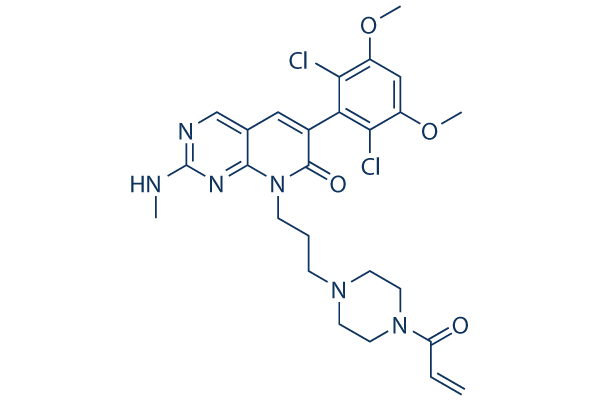| Description: |
PRN1371 is a highly selective and potent FGFR1-4 inhibitor with IC50 values of 0.6, 1.3, 4.1 and 19.3 nM, respectively. |
| Target: |
FGFR1:0.6 nM (IC50)
FGFR2:1.3 nM (IC50)
FGFR3:4.1 nM (IC50)
FGFR4:19.3 nM (IC50) |
| In Vivo: |
PK studies of PRN1371 in rat, dog, and cynomolgus monkey show rapid iv clearance in all species. PRN1371 shows rapid clearance (Cl=160 mL per min per kg), yet dosing po (20 mg/kg) demonstrates high oral exposure (AUC=4348 h·ng/mL) and a reasonable half-life (t1/2=3.8 h). Low levels of pFGFR2 confirms the ability of PRN1371 to block FGFR2 activity in tumor tissue. PRN1371 induces a dose-dependent reduction in tumor volume and up to 68% tumor growth inhibition at the highest dose of 10 mg/kg b.i.d. following 27 days of treatment. All doses are well tolerated with no significant body weight loss. PRN1371 free base has been administered orally once daily as powder in a capsule on a 28-day continuous schedule. Human plasma concentrations for doses ranging from 15 to 35 mg confirm good oral exposure, rapid systemic clearance, no accumulation from day 1 to day 15, and a dose-dependent increase in AUC. Serum phosphate, a pharmacodynamic marker of FGFR inhibition, is increased for all doses studied and shows a dose-dependent increase between 20 and 35 mg, despite the administration of prophylactic phosphate binders[1]. |
| In Vitro: |
PRN1371 presents a unique profile of high biochemical and cellular potency (FGFR1 IC50=0.6 nM, SNU16 IC50=2.6 nM), prolonged target engagement (FGFR1 occupancy 24 h=96%), < 30% hERG inhibition at 1 μM, and good predicted ADME stability with BME reactivity Kd>100 μM. Broader kinome-wide biochemical profiling of PRN1371 against 251 kinases identifies only FGFR1−4 and CSF1R as being potently inhibited[1]. |
| Kinase Assay: |
Enzyme inhibition is determined using a Caliper capillary electrophoresis system that separates phosphorylated and nonphosphorylated peptides on the basis of charge. Different concentrations of PRN1371 are first preincubated with enzyme for 15 min. The reaction is initiated with addition of peptide substrate, ATP, and Mg2+ and incubated at 25°C for 3 h. To stop the reaction, the mixture is quenched with EDTA. The buffer is 100 mM HEPES, pH 7.5, 0.1% BSA, 0.01% Triton X-100, 1 mM DTT, 10 mM MgCl2, 10 mM sodium orthovanadate, 10 μM β-glycerophosphate, and 1% DMSO. The ATP concentration of the reaction is at the predetermined value of the Km for ATP[1]. |
| Cell Assay: |
SNU16 cells are first seeded into 384- well plates and PRN1371 added such that the highest final compound concentration is 5 μM. Cells are incubated with PRN1371 for 72 h at 37°C. To detect viability, the Presto-Blue cell viability reagent is added. Plates are read using an Analyst HT with a fluorescent mode employing 530 nm excitation and 590 nm emission[1]. |
| Animal Administration: |
Mice: PRN1371 is evaluated in pharmacodynamics and efficacy studies using a SNU16 gastric cancer xenograft mouse model with high overexpression of FGFR2. In nude mice implanted with subcutaneous SNU16 tumors, pFGFR2 levels in the tumor are measured via Western blotting at 8 h following a 10 mg/kg oral dose. Low levels of pFGFR2 confirmed the ability of compound 34 to block FGFR2 activity in tumor tissue. Efficacy is determined by measuring tumor growth inhibition in the same SNU16 xenograft model[1]. |
| References: |
[1]. Brameld KA, et al. Discovery of the Irreversible Covalent FGFR Inhibitor 8-(3-(4-Acryloylpiperazin-1-yl)propyl)-6-(2,6-dichloro-3,5-dimethoxyphenyl)-2-(methylamino)pyrido[2,3-d]pyrimidin-7(8H)-one (PRN1371) for the Treatment of Solid Tumors. J Med Chem. 2017 Aug 10;60(15):6516-6527. |






















